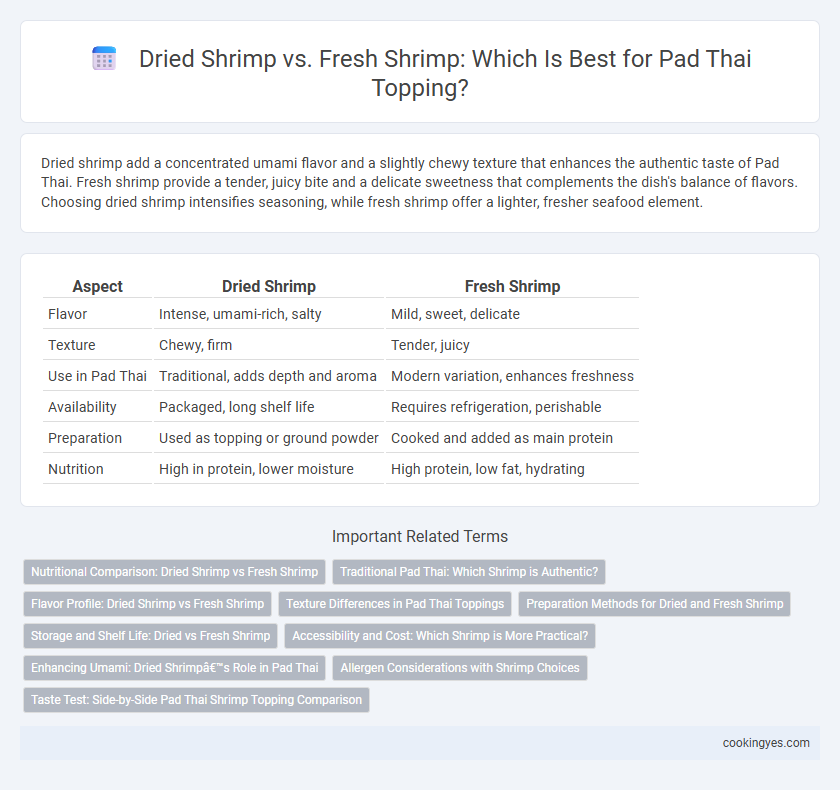Dried shrimp add a concentrated umami flavor and a slightly chewy texture that enhances the authentic taste of Pad Thai. Fresh shrimp provide a tender, juicy bite and a delicate sweetness that complements the dish's balance of flavors. Choosing dried shrimp intensifies seasoning, while fresh shrimp offer a lighter, fresher seafood element.
Table of Comparison
| Aspect | Dried Shrimp | Fresh Shrimp |
|---|---|---|
| Flavor | Intense, umami-rich, salty | Mild, sweet, delicate |
| Texture | Chewy, firm | Tender, juicy |
| Use in Pad Thai | Traditional, adds depth and aroma | Modern variation, enhances freshness |
| Availability | Packaged, long shelf life | Requires refrigeration, perishable |
| Preparation | Used as topping or ground powder | Cooked and added as main protein |
| Nutrition | High in protein, lower moisture | High protein, low fat, hydrating |
Nutritional Comparison: Dried Shrimp vs Fresh Shrimp
Dried shrimp contain higher concentrations of protein, calcium, and sodium compared to fresh shrimp, making them a nutrient-dense topping for Pad Thai. Fresh shrimp provide more moisture and lower sodium levels, contributing to a lighter texture and reduced salt intake. Choosing between dried and fresh shrimp depends on nutritional goals, with dried shrimp offering enhanced minerals and fresh shrimp promoting hydration and lower sodium consumption.
Traditional Pad Thai: Which Shrimp is Authentic?
Traditional Pad Thai authenticates its flavor with dried shrimp, which imparts a concentrated umami and signature savory depth that fresh shrimp lacks. Dried shrimp are sun-dried and slightly fermented, enriching the dish with intense, salty notes crucial for a genuine taste profile. Fresh shrimp, while tender and juicy, are more commonly used as a modern variation, but they do not replicate the traditional aroma or complexity in classic Pad Thai recipes.
Flavor Profile: Dried Shrimp vs Fresh Shrimp
Dried shrimp adds a concentrated umami flavor with a slightly salty and savory punch, intensifying the overall taste of Pad Thai. Fresh shrimp offers a milder, sweeter, and more delicate seafood flavor, contributing a tender texture that contrasts with the noodle dish. Choosing dried shrimp enhances depth and complexity, while fresh shrimp brings a clean, subtle seafood taste ideal for a lighter profile.
Texture Differences in Pad Thai Toppings
Dried shrimp in Pad Thai toppings offer a chewy, slightly crispy texture that adds a concentrated umami flavor, creating a contrast to the soft rice noodles. Fresh shrimp provides a tender, juicy bite that enhances the dish's freshness and balances the stir-fried ingredients. Choosing between dried and fresh shrimp significantly affects the overall mouthfeel and richness of Pad Thai.
Preparation Methods for Dried and Fresh Shrimp
Dried shrimp for Pad Thai require soaking in warm water before use to rehydrate and soften while intensifying their umami flavor. Fresh shrimp must be peeled, deveined, and quickly sauteed or stir-fried, preserving a tender texture and subtle sweetness. Both preparation methods significantly influence the overall taste and texture profile of the dish, with dried shrimp adding a concentrated savory depth and fresh shrimp contributing a delicate, juicy bite.
Storage and Shelf Life: Dried vs Fresh Shrimp
Dried shrimp offers a longer shelf life than fresh shrimp due to its low moisture content, making it ideal for extended storage at room temperature or refrigeration without spoiling quickly. Fresh shrimp requires prompt refrigeration and has a significantly shorter shelf life, typically lasting only 1-2 days before it can develop off odors or spoil. For Pad Thai toppings, dried shrimp ensures consistent availability and flavor preservation over months, while fresh shrimp provides a softer texture but demands careful handling and faster consumption.
Accessibility and Cost: Which Shrimp is More Practical?
Dried shrimp is more accessible and cost-effective for Pad Thai, commonly available in Asian markets and supermarkets at a lower price point than fresh shrimp. Fresh shrimp provides a superior texture and flavor but can be expensive and requires refrigeration, limiting its practicality for everyday cooking. For budget-conscious or convenience-focused cooks, dried shrimp offers a practical solution without sacrificing the authentic taste of Pad Thai.
Enhancing Umami: Dried Shrimp’s Role in Pad Thai
Dried shrimp significantly enhance Pad Thai's umami profile by providing a concentrated savory depth that fresh shrimp cannot match. Their intense flavor intensifies the dish's complexity, enriching the balance between sweet, sour, and salty elements essential to authentic Pad Thai. Incorporating dried shrimp topping delivers a bold, aromatic punch that elevates the traditional noodle stir-fry to a more flavorful and satisfying experience.
Allergen Considerations with Shrimp Choices
Choosing dried shrimp for Pad Thai toppings introduces concentrated allergenic proteins that may heighten allergic reactions compared to fresh shrimp. Fresh shrimp contains more moisture and tends to have a milder allergen profile, potentially reducing sensitivity in shrimp-allergic individuals. Both options require careful allergen labeling since shrimp is a common seafood allergen responsible for severe IgE-mediated hypersensitivity reactions.
Taste Test: Side-by-Side Pad Thai Shrimp Topping Comparison
Dried shrimp in Pad Thai offers a concentrated umami flavor and chewy texture, enhancing the dish's traditional savory notes, while fresh shrimp contributes a juicy, tender bite with a milder seafood taste. A taste test comparing both toppings reveals that dried shrimp intensifies the depth of flavor, complementing the stir-fried noodles and tamarind sauce, whereas fresh shrimp provides a fresher, lighter contrast. Choosing between dried and fresh shrimp depends on desired texture and flavor profile, with dried shrimp delivering complexity and fresh shrimp emphasizing delicacy.
Dried shrimp vs fresh shrimp for Pad Thai topping Infographic

 cookingyes.com
cookingyes.com